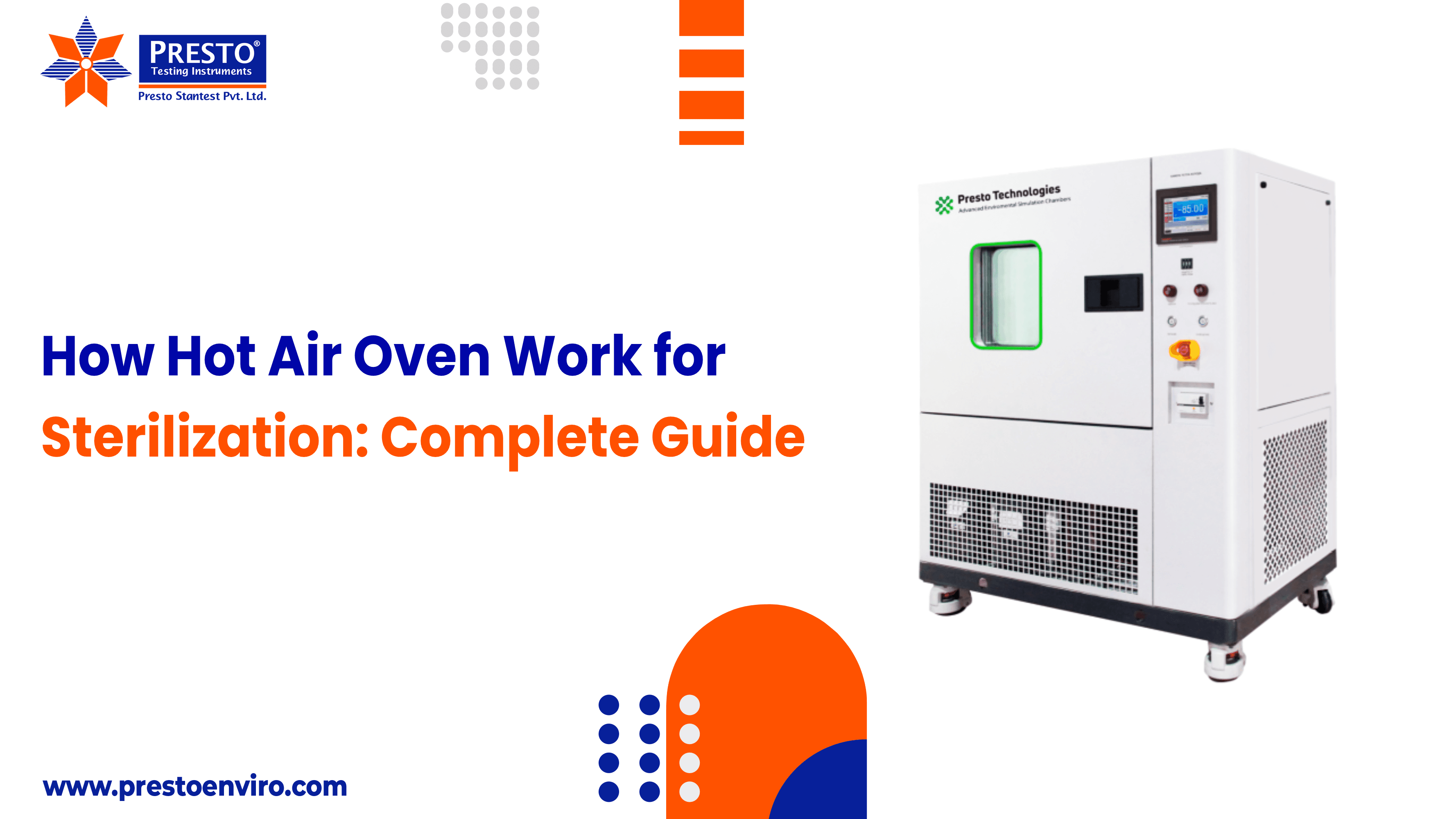© Copyright 2025. All Rights Reserved by Presto Enviro Pvt. Ltd.

06-Oct-2025
Presto Enviro
The Hot Air Oven is a temperature, time, and heat method of sterilization that is used in labs as well as by industries. The hot air oven sterilizes by circulating heated air, but is distinguished from moist autoclaving, in which sterilization occurs by moisture. A hot air oven removes microorganisms, spores, and other contaminants from laboratory equipment successfully.
Hot air sterilization works by keeping the temperature at a specified range of time while killing. Hot air is not very complex and very dependable and is inexpensive to procure, making it a mainstay in medical laboratories, pharmaceutical laboratories, and research laboratories that require sterile lab space.
A hot air oven is equipment designed for situations where products are evenly heated at a specific temperature. It can also serve as a sterilizing device to destroy germs, bacteria, and microorganisms. The hot air oven operates at a specific temperature for a specific period of time, and there may be situations where the humidity is controlled as well.
The hot air oven will control moisture by removing the water from the items that are to be heated. The warm air is circulated through the oven by a fan, which promotes even heating and an even distribution of heat throughout the items. This process will render the product safe for human and/or animal consumption and free from pathogenic microorganisms.
Hot air ovens are necessary sterilizers for the effective destruction of microorganisms on heat-resistant, non-moisture-sensitive materials (such as glassware, metal instruments, and powders) by means of dry heat.
Compared to moist heat methods, dry heat penetrates thick materials and does not corrode or rust metals. Thus, an oven is required to achieve high levels of sterility without damaging less resilient items and not leaving harmful residues.
The importance of Hot Air Ovens:-
Hot air ovens rely on the method of sterilization via dry heat in which microorganisms are killed through oxidation at high temperatures. Dry heat sterilization is suitable for sterilization of instruments that can withstand high heat without being damaged, including some powders, metal instruments, and glassware.
Here is the step-wise process:
Before starting the test confirm that all items are washed and are in the trays in the proper order and ready to be sterilized. The glassware and instruments should be dirt free and moisture free. The oven has been verified to be clean, operational, and at the appropriate sterilization temperature.
When oven is ON, the heat is turned up slowly to reach the desired temperature. The hot air is circulated uniformly to every corner of the chamber so that all surfaces of the item will be heated. This allows the material to be heated consistently through the process so the material can be sterilized effectively.
After the desired set temperature is achieved, the sterilization cycle starts. Products are held at this temperature for a certain period, during which time the heat kills off bacteria, spores, and other forms of microorganisms. The cycle duration varies with the material type and extent of sterilization needed.
After the sterilization cycle has finished the oven is turned off and gradually cooled. Temperature shifts are not rapid enough to prevent potential damage to the contents. Once cool to a safe working temperature the trays can be extracted from the oven.
When you remove sterilized materials, you will do so with clean gloves or instruments to prevent contamination. They may be used immediately or kept in sterilization conditions until usage. Proper removal prevents the loss of sterilization efficacy and also upholds the cleanliness of the instruments.
A hot air oven offers several advantages such as Simple to operate, Uniform heat distribution, no risk of rust or corrosion, cost-effective & reliable.
Here are the advantages explained in detail:
A hot air oven is good for sterilizing materials that have high heat resistance including metal instruments, glassware and powders. It should be noted that dry heat does not cause damage related to moisture, corrosion, or rusting, and it makes it great for sensitive or fragile materials to retain their integrity.
It is easy to use a hot air oven. The users just have to adjust the required temperature and sterilizing time. The oven heats hot air automatically, and not much technical skills are needed in handling it. This ease of operation minimizes errors, and training becomes less complicated. Laboratories and industries can achieve standardized sterilization without technical experts.
Hot air oven is depends on natural convection to distribute the heat so it reaches properly at every end and size. For example, items that are stacked in trays or containers will be heated correctly and no part of the product will be exposed to insufficient heat.
Because hot air ovens use dry heat instead of steam or moist heat, metal instruments will not rust or corrode. This is particularly helpful for surgical instruments, laboratory glassware, and precision instruments, so that all of these can remain functional for many cycles of sterilization and last in service longer.
Hot air sterilizers are reliable, long-lasting, low-maintenance, and use relatively low amounts of energy. They provide a long-term solution for routine sterilizing needs in laboratories, hospitals, and industry. Their reliability yields a promise of consistent outcomes, and they are more cost-effective compared to sterilizing instruments requiring more sophisticated or more maintenance.
Hot air ovens are essential equipment used for safe sterilization of equipment and materials in laboratories, hospitals, and industries. Hot air ovens use controlled dry heat and ensure that dry heat is evenly distributed to and maintained at a sustained temperature. Thus, hot air ovens are a dependable and effective method of killing undesired microorganisms, for maximized safety and sterilization, in numerous applications.
Elevate your quality assurance process to new heights